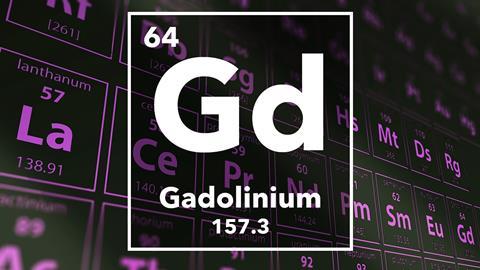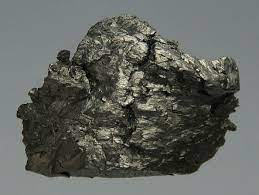Identity.
Gadolinium (Gd), with its atomic number 64 and silvery gleam, is a
member of the rare-earth family. Although not abundant, it carries
unique properties hidden beneath its unassuming facade. This soft,
malleable metal boasts a powerful magnetic personality, switching from
paramagnetic to ferromagnetic – stronger than nickel – at cool
temperatures. It shines in medical settings as a contrast agent in
MRIs, revealing secrets within our bodies. Beyond its medical feats,
gadolinium strengthens alloys, enhances fuel cells, and even dabbles
in the world of lasers. Gadolinium, once unknown, continues to unlock
its potential, proving itself a valuable element worthy of
exploration.
Atomic Structure:
Gadolinium is a rare earth metal with atomic number 64, an atomic
weight of 157.25, and a density of 7.89 Mg/m3. Its melting point is
1312 C, and it boils at 3000 C. The electronic configuration of
Gadolinium is: (Xe)(4f 7)(5d1)(6s2).
History.
The story of gadolinium begins in 1792 with Finnish chemist Johan
Gadolin, who isolated the first rare-earth compound from a black
mineral later named gadolinite. But the true identity of gadolinium
remained hidden for almost a century. Fast forward to 1880, when Swiss
chemist Jean Charles Galissard de Marignac noticed curious spectral
lines in samples of gadolinite and another mineral. These lines
differed from known elements, hinting at something new. The race was
on! French chemist Paul-Émile Lecoq de Boisbaudran finally isolated
the pure element in 1886, recognizing its connection to gadolinite and
christening it "gadolinium."
The early 20th century saw scientists unraveling gadolinium's
unique properties. Its strong magnetism caught attention, leading
to its use in alloys for stronger magnets. Meanwhile, the
discovery of its neutron-absorbing ability paved the way for
applications in nuclear technology. In the 1980s, gadolinium
compounds revolutionized medical imaging with the advent of MRI
contrast agents, offering unparalleled insights into human
anatomy.
However, the journey of gadolinium is not without challenges. As
its medical use soared, questions emerged regarding potential side
effects and concerns about gadolinium deposition in the body.
Research continues to refine its application while exploring
exciting new possibilities, including fuel cells, lasers, and even
quantum computing. Gadolinium's story continues to unfold,
reminding us that scientific discoveries are often journeys with
unexpected twists and turns.
Usage.
From enhancing medical scans to powering nuclear reactors, gadolinium
boasts a diverse repertoire. In hospitals, it illuminates hidden
details in MRIs, guiding diagnoses of tumors and inflammation. At
power plants, it acts as a guardian angel, absorbing neutrons in
control rods and shields to ensure safety. Beyond these roles,
gadolinium strengthens alloys for tech gadgets, fuels green energy
initiatives, and even sparks innovation in cutting-edge lasers. This
versatile element truly packs a punch, leaving its mark on various
sectors of our world.
-
Medical Marvel: Gadolinium-based contrast agents are key
players in Magnetic Resonance Imaging (MRI), enhancing image
clarity and aiding in the diagnosis of tumors, inflammation, and
other abnormalities. They work by shortening the relaxation time
of water molecules near tissues of interest, making them appear
brighter on the image.
-
Nuclear Champion: Due to its exceptional neutron absorption
capacity, gadolinium finds crucial applications in the nuclear
field. It is used in: Control rods of nuclear reactors to regulate
power output and emergency shutdowns. Shielding materials to
protect personnel and equipment from radiation. Fuel "poisons" in
specific reactor designs to fine-tune neutron flux.
-
Tech Trailblazer: Gadolinium isn't just confined to
medicine and nuclear power. It also: Strengthens metal alloys for
applications in electronics, data storage, and even aircraft
components. Drives high-performance magnets used in motors,
speakers, and medical devices. Contributes to green technology by
enabling efficient fuel cells and potentially improving laser
designs.
Some of the benefits of using Gadolinium are:
-
Gadolinium-based contrast agents are lifesavers in medical
imaging, particularly MRI scans. They illuminate specific tissues
and abnormalities, allowing doctors to diagnose tumors,
inflammation, and other conditions with much greater accuracy than
without the contrast. This leads to earlier interventions and
improved patient outcomes.
-
Gadolinium plays a crucial role in ensuring the safe operation of
nuclear reactors. Its exceptional neutron-absorbing properties
make it invaluable for: Control rods: Regulating power output and
initiating emergency shutdowns. Shielding materials: Protecting
personnel and equipment from harmful radiation. Fuel "poisons":
Fine-tuning neutron flux for optimal energy production and safety.
-
Gadolinium is a versatile element that strengthens and improves
various technologies: Strengthened alloys: Used in electronics,
data storage, and even aircraft components, gadolinium enhances
their durability and performance. High-performance magnets:
Gadolinium-based magnets power motors, speakers, and medical
devices, offering superior strength and efficiency. Green
Technology: This element contributes to sustainable solutions by
enabling efficient fuel cells and potentially improving laser
designs for renewable energy applications.
-
As research continues, gadolinium's full potential is still being
explored. It holds promise for exciting advancements in fields
like: Quantum computing: Exploring its unique magnetic properties
for next-generation computing possibilities. Drug delivery:
Utilizing its properties to develop targeted drug delivery systems
with improved efficacy. Material science: Investigating its
potential for novel materials with unique functionalities.
Sources.
While gadolinium plays a big role in our world, it isn't exactly
hanging out on street corners. It primarily hides within two shy
minerals: monazite and bastnäsite. These unassuming rocks, found in
parts of China, the US, Brazil, and more, harbor this valuable
element. Extraction involves a multi-step process, coaxing gadolinium
out through acid baths and chemical transformations. While it's not
the most abundant element, it's surprisingly accessible within these
mineral companions, waiting to be unlocked and put to good use.
Properties.
Magnetic Marvel: Unlike most metals, gadolinium undergoes a
curious transformation at cooler temperatures. Below its Curie point
of around 293°C, it turns ferromagnetic, meaning it exhibits strong
and long-range attraction to magnets. This unique property fuels its
use in high-performance magnets found in electronics, data storage,
and even medical devices.
Neutron Ninja: Gadolinium is a champion at absorbing neutrons,
tiny particles emitted during nuclear reactions. This ability makes it
a crucial player in nuclear safety: Control rods: Containing
gadolinium absorb excess neutrons in reactors, regulating power output
and enabling shutdowns. Shielding: Gadolinium-based materials act as
shields, protecting personnel and equipment from harmful radiation.
Medical MVP: In the realm of medicine, gadolinium shines as a
contrast agent in MRI scans. Compounds containing this element
interact with water molecules in the body, making specific tissues
appear brighter on the images. This enhanced view empowers doctors to
diagnose tumors, inflammation, and other abnormalities with increased
accuracy.

